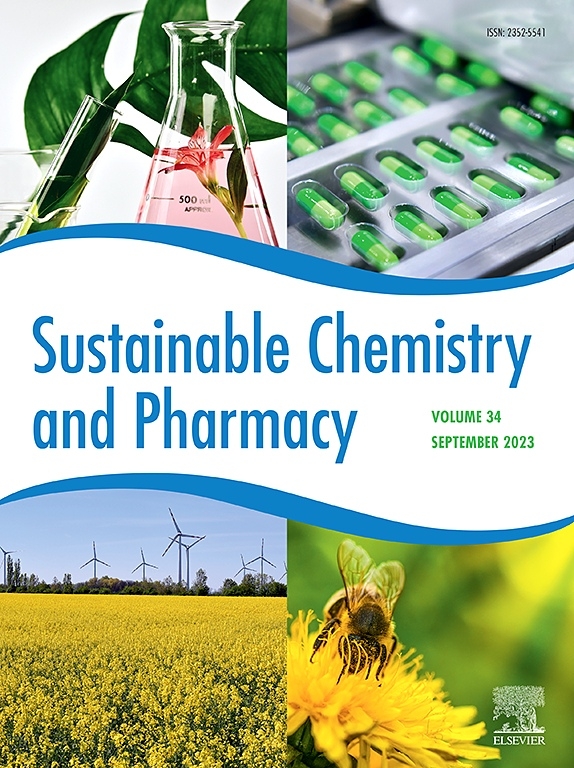以玉米油为溶剂,微波和超声波辅助提取脱水枸杞中玉米黄质的绿色优化
IF 5.8
2区 化学
Q2 CHEMISTRY, MULTIDISCIPLINARY
引用次数: 0
摘要
本研究以食品级玉米油为绿色溶剂,对超声波辅助提取法(UAE)和微波辅助提取法(MAE)从枸杞子冻干中提取玉米黄质进行了研究和比较。采用响应面法(RSM)对两种工艺进行了优化。选择的变量组合为UAE的超声振幅和处理时间,MAE的微波功率和处理时间。对富含玉米黄质的玉米油和商品玉米油进行了类胡萝卜素含量、颜色和氧化稳定性的表征。UAE的提取率最高(68%;151.8 mg玉米黄质/kg油),而MAE (54.5%;116.88±1.77 mg玉米黄质/kg油)。两种提取方法都能得到比原始玉米油更深、更深、更鲜艳的橙色富集油,其氧化稳定性与未富集玉米油一样。在环境影响方面,MAE的能源消耗和二氧化碳排放量低于阿联酋,但后者的石油富集程度最高。与传统的基于有机溶剂的方法相比,提出的使用食用油的无溶剂方法最大限度地降低了毒性,消除了提取后溶剂去除的需要,并允许将浓缩产品直接应用于食品体系中。虽然提供最大产量的提取条件不是最环保的,但MAE代表了一种更可持续的替代方案。这些发现强调了在设计绿色提取工艺时需要平衡提取效率和环境影响。所得到的富含玉米黄质的玉米油可作为功能性成分和天然着色剂用于食品工业。本文章由计算机程序翻译,如有差异,请以英文原文为准。

Green optimization of microwave and ultrasound-assisted extraction of zeaxanthin from dehydrated goji berries using corn oil as a solvent
This research aimed to investigate and compare the extraction of zeaxanthin from lyophilised goji berries using ultrasonic-assisted extraction (UAE) and microwave-assisted extraction (MAE), employing food-grade corn oil as a green solvent. Optimisation of both processes was carried out using Response Surface Methodology (RSM). The selected combinations of variables studied were the ultrasonic amplitude and treatment time for UAE and microwave power and treatment time for MAE. The zeaxanthin-enriched corn oils and the commercial corn oil were characterised for carotenoids content, colour and oxidative stability. The highest extraction yields were obtained for UAE (68 %; 151.8 mg zeaxanthin/kg oil), while for MAE (54.5 %; 116.88 ± 1.77 mg zeaxanthin/kg oil). Both extraction methods result in enriched oils with darker, deeper, and more vivid orange colours than the original corn oil, with oxidation stability like that of the no enriched corn oil. In terms of environmental impact, MAE had lower energy consumption and CO2 emissions than UAE, but the latter achieved the highest oil enrichment.
Compared to conventional organic solvent-based methods, the proposed solvent-free approach using edible oil minimizes toxicity, eliminates the need for post-extraction solvent removal, and allows direct application of the enriched product in food systems. Although the extraction condition providing maximum yield was not the greenest, MAE represented a more sustainable alternative. These findings highlight the need to balance extraction efficiency and environmental impact when designing green extraction processes. The resulting zeaxanthin-enriched corn oil could be used as a functional ingredient and natural colourant for the food industry.
求助全文
通过发布文献求助,成功后即可免费获取论文全文。
去求助
来源期刊

Sustainable Chemistry and Pharmacy
Environmental Science-Pollution
CiteScore
8.20
自引率
6.70%
发文量
274
审稿时长
37 days
期刊介绍:
Sustainable Chemistry and Pharmacy publishes research that is related to chemistry, pharmacy and sustainability science in a forward oriented manner. It provides a unique forum for the publication of innovative research on the intersection and overlap of chemistry and pharmacy on the one hand and sustainability on the other hand. This includes contributions related to increasing sustainability of chemistry and pharmaceutical science and industries itself as well as their products in relation to the contribution of these to sustainability itself. As an interdisciplinary and transdisciplinary journal it addresses all sustainability related issues along the life cycle of chemical and pharmaceutical products form resource related topics until the end of life of products. This includes not only natural science based approaches and issues but also from humanities, social science and economics as far as they are dealing with sustainability related to chemistry and pharmacy. Sustainable Chemistry and Pharmacy aims at bridging between disciplines as well as developing and developed countries.
 求助内容:
求助内容: 应助结果提醒方式:
应助结果提醒方式:


